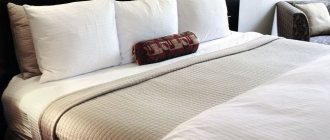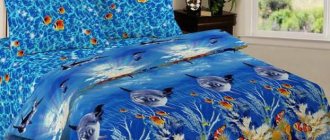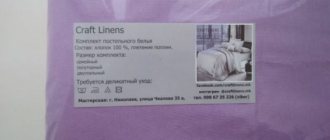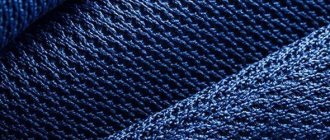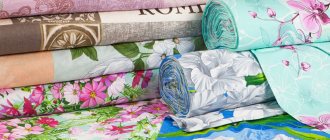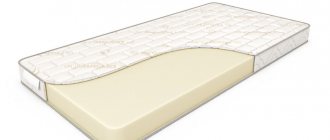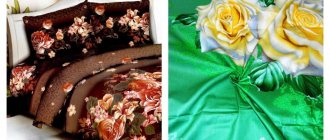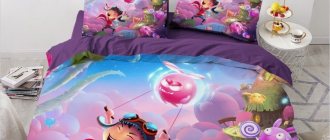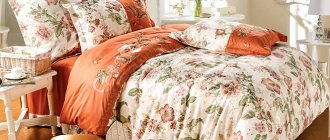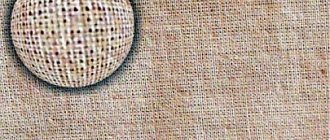Twill satin is a modern type of fabric, very popular in the modern world of textiles. Cotton fibers are woven in a certain way with a “satin weave”, which gives the fabric special qualities.
They are intertwined with a symmetrical step of 2 to 2. This leads to the creation of a material with a lower density than ordinary satin, although there are practically no differences in external qualities.
Description
What is twill-satin fabric? Visually, you are unlikely to distinguish it from ordinary satin; what distinguishes one material from another is its density. The difference between satin and twill-satin is that in the first case the weave is characterized by a step of one thread to three, and in the second - two to two.
The weaving method makes twill-satin fabric less dense, and therefore more affordable. Otherwise, you won't notice any significant differences. The same shine and gloss, as well as the environmental properties of the material - all this remains unchanged. Therefore, it is difficult to say which is better, it all depends on what is preferable for you - the density of the material or its affordable price. The price per linear meter starts from 135 rubles.
You can see what the matter looks like in the photo.
Material characteristics
Twill-satin is a material that consists of satin and cotton with a certain percentage of components. A characteristic feature of this fabric is the special order of weaving the threads - symmetrical, 2: 2. This makes it durable, but at the same time soft. The texture of this fabric resembles satin, although it is less dense. Externally, these two varieties are very similar, they are smooth, silky and shiny, but the main difference is the lower cost of twill satin. The main characteristics of the fabric include:
- strength;
- hygiene;
- shine and softness;
- resistance to deformation;
- slight creasing;
- breathability;
- ease of washing;
- durability;
- low price.
The fabric is natural and hypoallergenic, since it consists mainly of cotton, and it also absorbs water well. The so-called mixed twill-satin is more common. It consists of only 35% cotton, the remaining percentage is synthetic or viscose. The properties of this material are somewhat worse than natural ones, but it has increased strength and a low price. The most comfortable features are the fabric consisting of 50% cotton.
The viscose in the composition gives the material smoothness and increases thermal properties. Twill fabric is predominantly plain-dyed, although prints are also applied to it.
There are practically no downsides to this material.
Description of twill-satin: how does the fabric differ from regular satin?
What is the difference between twill-satin (twill-satin is a misspelling) and classic satin? Externally, these tissues cannot be distinguished from each other with the naked eye. Their main difference is the amount of fibers used in the manufacturing process. When producing standard satin, there are 4 warp threads per 1 weft thread. When making twill satin, an equal number of weft and warp threads are used - 2 each (less often 3). Due to this, twill-satin fabric is less durable and, accordingly, cheaper than satin.
Cotton twill satin
This fabric is produced using twill or diagonal weave, in which the weft and warp are intertwined at a constant pitch. Each subsequent row of fabric is shifted by one thread, resulting in a diagonal rib. As a rule, when producing this type of fabric, in addition to cotton raw materials, additional fibers are included in the composition of the fabric - polyester, elastane, wool, silk. There are many varieties of this fabric. General information about them is presented in the table:
Twill stretch
| Classification method | Types of twill-satin | Characteristics |
| By composition | Cotton | This is an absolutely natural product of the textile industry. Due to its high hygienic properties, it is widely used for sewing summer clothes. |
| Silk (twill stretch) | To give the fabric elasticity, its composition includes from 2 to 5% elastane or lycra. This material feels like silk to the touch. | |
| Mixed | It is obtained by combining cotton raw materials with synthetic fibers in various proportions. This fabric is often used for sewing suits, uniforms, workwear, jackets, and raincoats. To impart water-repellent and windproof properties to the surface of products made from mixed fabric, a polyurethane coating is applied to the fabric on the reverse side before sewing. | |
| By dyeing method | Mullined | Multi-colored twisted threads are used. |
| Plain painted | The canvas is painted in one color. | |
| Melange | 2 shades combined. | |
| Printed | Prints (patterns or designs) are applied to the material. |
Printed twill satin
A little origin story
Tweed has Scottish roots. In the south of the Isle of Lewis, sheep are raised and their wool is turned into thick, coarse and scratchy threads of untwisted yarn. It is painted in the natural colors of the surrounding landscapes, and as a result of the weaving, a “crow’s feet” pattern is obtained.
The production of tweed fabric, according to the description, begins with shearing sheep. Wool raw materials are selected, cleaned by washing and dyed with plant pigments. The wool fibers are combed and several colors are mixed with metal teeth according to strict, ancient rules. Hand looms produce threads and weave fabric. Soaking in soapy water, called waulking, helps soften the material. Then they beat with special hammers while singing songs with an accelerating rhythm.
For a long time, clothes made from tweed linen were intended for workers and the poor. Until it entered the lives of wealthy people thanks to hunting, horse riding and the advent of factory production.
Compound
The final cost of twill-satin depends on the raw materials present in the composition. And there is plenty to choose from:
- Typically, twill-satin material is made from natural cotton - this is the most common option from which beautiful bedding sets are sewn, which we will talk about below
- Silk with the addition of elastane - suitable for sewing elegant and casual clothes
- Cotton and stretch - this fabric stretches perfectly and is suitable for creating outfits that are worn every day, as well as underwear
- Material with added synthetic fiber, such as polyester. The percentage of synthetics is increased, but since this does not in any way affect the elegant appearance of the fabric, and at the same time significantly increases its density, the material is used as decorative textiles for the home (curtains, draperies), as well as for upholstery of upholstered furniture. Read more about what kind of stripe satin fabric this is and what its features are.
Application
Twill satin is a fabric developed for sewing home textiles. In addition to bed linen, which serves as a worthy alternative to standard satin, it is used to create:
- casual clothes. Pleasant to the body, does not cause discomfort, there is no restriction in movements;
- children's sets. Prevents fogging by removing excess moisture. The ability to allow air to pass through eliminates fogging, which causes irritation;
- underwear, dressing gowns;
- upholstery of sofas, armchairs, chairs;
- curtains, curtains;
- men's shirts, women's dresses.
For information! Durable fabric containing synthetic fibers protects against dust and dirt. Ideal for sewing workwear.
Twin satin bed linen
The most common type of application is making bed linen. Many variations have been developed to suit any bed size. A variety of colors and textures allows you to choose a model that suits your planned style.
Note! You can complement the set with a bedspread made in an identical color scheme.
Durable material creates a cozy atmosphere and enhances comfort during sleep. This is achieved by moisture removal and breathability. Good heat exchange allows you to retain heat. The bed does not cool down immediately after waking up.
Advantages and disadvantages
The main advantage of this fabric is its hygiene and safety. In the twill-satin production process, only the most environmentally friendly and soft compounds are used, including dyes. Thanks to this, textiles are not able to release harmful toxic substances or negatively affect the skin or the body as a whole.
Pros:
- hygiene;
- strength;
- softness;
- ease;
- elasticity;
- beautiful appearance;
- color fastness;
- hypoallergenic;
- weak creasing;
- wear resistance;
- hygroscopicity;
- practicality.
Minuses:
- accumulation of static electricity;
- need for careful care.
Tailoring of workwear
According to SanPiN, work clothes for production must have the following qualities:
- hygiene (air permeability and hygroscopicity of fabric);
- dustproof, protection from external mechanical influences;
- absence of allergens;
- ease of movement;
- durability in maintaining shape and appearance.
Modern mixed fabrics fully meet these requirements. Permanent dyes helped diversify the design. Twill workwear, along with expediency and practicality, brought harmony of aesthetics to work clothes.
The advantages of twill are used in uniform tailoring for:
- doctors, laboratory technicians;
- workers of industrial enterprises;
- workers in the service sector (hotels, shops, catering establishments);
- military personnel, law enforcement officers and the Ministry of Emergency Situations, security company employees;
- corporate clothing for staff.
Workwear solves not only the protective, aesthetic problems of the employee’s appearance, but also marketing and advertising issues of production, psychologically contributes to team unity and strengthening the corporate spirit.
Kinds
The material may also differ in the method of dyeing:
- Mulinated. Twisted threads of different shades are used here, which allows you to create canvases with an interesting color pattern
- Smoothly colored. The canvas is painted in one shade
- Melange. The canvas combines two colors
- Printed. Prints, patterns, and various designs are applied to the fabric.
Where is twill weaving used?
The area of use of the material is the production of uniforms and work clothes. It is used to make overalls and suits, jackets and trousers, as well as caps, berets and caps. Fabric with a waterproof coating is used to produce special uniforms, equipment for fishermen and tourists.
Twill has found application:
- Casual women's and men's wardrobe for summer.
- Lightweight outerwear: sports jackets, raincoats and windbreakers.
- Things for children made of cotton twill satin.
- Interior textiles: curtains, curtains, lambrequins.
- Household products: napkins, tablecloths, bed linen.
- Mixed types are used for furniture covers.
- As a lining material.
- Twill is even used to make shopping bags, children's bags, and sports backpacks.
Bed linen made from twill fabric is not inferior to satin, and even surpasses it in use and care. Easy to iron and wash. Bedding sets made of silk twill look elegant and luxurious. These sheets do not slip or wrinkle.
Advantages and disadvantages of twill.
Like any other material, twill has a number of advantages and disadvantages. Let's look at them in more detail.
Positive traits:
- Resistant to washing at high temperatures;
- Dries quickly;
- Does not require special knowledge for care;
- Able to last for many years;
- Does not fade;
- Resistant to moisture;
- Comfortable to wear;
- Easy to cut;
- Suitable for various weather conditions;
- Has high strength;
- Has a peculiar shine.
Black twill.
The material has few disadvantages, but still has them :
- Mixed twill, due to the presence of synthetics, can cause allergic reactions;
- Relatively high prices for some types of fabric. It is worth noting that the price of the material may depend on several factors: the composition of the raw materials, the country of production and the type of weaving 2x2 or 3x3.
- Possibility of electrification if the twill is made of synthetic fibers.
With or without filler
High-quality bedspreads with filling - quilted, stitched or glued.
Soldered products are created only from a combination of synthetics with natural fabrics, so they do not last too long.
You should pay attention to the lining fabric. Good options - natural or with impurities
The cape will not slide on the surface of the furniture, and static electricity will not begin to accumulate. In summer, cotton quilts are used instead of blankets.
Fillings are available natural (down, cotton, wool, silk) or artificial (sintepon, fibers impregnated with silicone, viscose). Combinations of paddings are also acceptable. For example, 10% synthetic threads are added to wool. This way you can prevent the stuffing from clumping.
The choice of bedspreads with or without filling is a matter of taste and budget of the buyer. Silk is very expensive, and down provokes allergic reactions. Synthetic winterizer is suitable in terms of price-quality ratio, as well as hypoallergenicity. Its disadvantage is very low air conductivity.
Properties
The characteristics of twill-satin, thanks to the use of natural raw materials, are as follows:
- Remarkable breathability
- The material perfectly absorbs moisture
- Does not cause allergic reactions or irritation
- Twill-satin almost does not wrinkle, it is easy and convenient to iron
- Excellent wear resistance - looks great and does not wear out even with intensive use and numerous washes
- Paints well and lasts a long time - does not fade
- Another property is dust repellence. If curtains are made from fabric, this is especially true
The photo shows fabric with lace trim.
Which weave is better
What types of bedspread fabrics are used in the production of cotton accessories:
teak is a dense plain or twill weave. It is made from natural raw materials: cotton, less often flax, hemp fibers. Teak is durable and wear-resistant. Additionally, it is impregnated with a special composition that does not allow the padding (if any) to appear on the outside of the product. Bedspreads made from this fabric are elastic and retain their shape. Serve for several decades;
satin is a smooth, thin, but durable material. Almost does not wrinkle when used. The peculiarity of weaving is the twisting of the threads, which is why the fabric becomes silky and smooth. The blanket made of cotton fibers of this weave is soft, takes the shape of the torso of a lying person, and envelops him. Breathes well, does not allow you to sweat;
satin jacquard. Satin weave, a convex pattern formed by placing threads in different directions. A bedspread with this weave looks expensive and luxurious. Composition: natural cotton or silk. The feel of a cotton blanket is smooth, so it looks like silk;
twill. Dense, wear-resistant material made of thick twill weave fibers, mainly made of cotton, sometimes containing wool threads. The cape is matte, durable, pleasant to the skin. This is a reliable, completely natural product;
percale. Made from long cotton fibers. For this reason, the threads do not twist together, but are placed evenly. To fix them, they are impregnated with an adhesive solution. The result is a durable, dense cotton bedspread that remains soft and pleasant to the touch. Withstands 1000 washes;
batiste. Cotton material made from the finest threads. The thing turns out to be tender, thin, flying. Suitable for bedspreads with down filling. The accessory is capable of taking the shape of a person’s torso and gently enveloping it. Cons: lack of elasticity and volume. Good for small children, people with sensitive skin.
Care
The fabric itself is not fancy, the main thing is to take into account the basic recommendations, and your item will retain its attractive appearance for a long time.
- Wash in water at a temperature not exceeding 40 degrees
- Use conditioner, this will make the material softer and extend its attractiveness.
- Do not use bleach or any chlorine-based cleaners
- Products should be dried away from direct sunlight and do not use heating devices for this purpose.
- It is better to iron the item when it is not completely dry
Marking
As we have already said, Oxford fabric comes in different densities. Depending on this, it is marked. The density of the fabric depends on the amount of DEN, which comes from the word "Denier". If we look at the marking of Oxford fabric, we will see the letter D, which denotes such a characteristic as density in DEN. There is a number next to this designation. The higher the density level of such a fabric and the thicker the threads, the higher the number will be. The marking also contains designations that indicate the types of fabric impregnation. The designation PVC indicates that the fabric is impregnated with polyvinyl chloride, and the designation PU indicates that the material is impregnated with a polyurethane composition.
Oxford fabric 150D
This type of fabric has a low density. Light raincoats, jackets and small covers are made from this material. All products do not allow water to pass through and do not allow dirt to collect between the fibers.
Oxford fabric 210D
The density of this fabric is slightly higher than that of 150D. This material is used for the production of all kinds of tourist accessories, various types of light uniforms for fishermen and hunters, for the production of light workwear, uniforms for employees of law enforcement agencies and various departmental organizations, in shoe production and the manufacture of haberdashery items, for the production of all kinds of equipment, life jackets, small covers, waterproof raincoats and other products.
Oxford fabric 240D PU
The material has a sufficient level of strength for the manufacture of backpacks, tents, travel equipment, items for hunting and fishing.
This fabric is impregnated with a polyurethane composition.
Such things have excellent water-repellent properties and are not exposed to sunlight.
Oxford fabric 300D PVC PU
This type of fabric is a hybrid material that is impregnated with a polyurethane composition and polyvinyl chloride.
This material is used for the production of shoes, bags, haberdashery items, accessories, equipment for tourists, accessories for hunters and fishing gear.
Oxford fabric 420D PVC PU
This is a hybrid fabric impregnated with polyvinyl chloride and polyurethane composition.
It has sufficient strength and is used for the manufacture of various kinds of accessories for tourist trips, special uniforms for fishermen and hunters, for the manufacture of workwear, uniforms for employees of law enforcement agencies and various departmental organizations.
It is also used in the production of shoes and the manufacture of haberdashery items.
Oxford fabric 600D PVC PU
This combined material, impregnated with a polyurethane composition and polyvinyl chloride, is used in the manufacture of awnings for tents and trade tents, various equipment for tourist trips, all kinds of products for hunters and fishermen, folding tables and chairs for tourist recreation, in the production of shoes, the manufacture of bags, haberdashery , and all kinds of accessories.
Oxford fabrics with a higher density of up to 1500 denier are used to make very durable and tough products. These can be bags, car awnings, covers for heavy and rough objects, etc.
A little history
Twill is a material that originated in Scotland, where high-quality fabrics were produced for several centuries. The cold, damp climate forced the local population to create materials that were wear-resistant and able to retain heat. There are two similar names: twill and tweed. They differ in the raw materials used for production.
Sample
Twill - what kind of fabric is this? This is a silky fabric, soft to the touch, resembling satin in appearance. Both types of material have a soft matte sheen, but twill has less density.
Twill is a twill weave fabric that contains several types of fibers. It can be:
- cotton;
- wool;
- silk;
- synthetics (polyester).
The following types of fabric are widely known:
- polysatin is a material that is identical in properties and characteristics to satin. Unlike the latter, polysatin contains a lot of synthetics;
- tweed. Several types of twill weave wool fabric are combined under this name.
Tweed
For your information! Twill is practical; the combination of synthetics and wool gives the material special strength and the ability to retain heat. The synthetic fibers in this fabric prevent it from shrinking and wrinkling.
This is interesting: Taslan fabric - description, features, where it is used
Varieties
Due to the fact that not only cotton, but also artificial fibers are used in the production of twill, the result is several types of fabric. Each of them has its own properties and application.
- Silk twill is used to make expensive and high-quality clothes. To improve practical characteristics, elastane is added to the composition in a 3% ratio. Compared to satin, twill requires more silk, which makes its cost and selling price higher.
- Elastic twill is produced with the addition of 20% viscose and 80% polyester. The stretching properties make it possible to significantly expand the range of application of the material. It has proven itself well in underwear: dresses, sweaters and the like.
- Twill cotton is a very durable fabric with a small elastane content. The range of applications is wide and varied.
- Twill twill is an excellent lining material. Does not wrinkle, drape, does not electrify. Retains brightness and shape over a long period of wear.
- The wool twill type is distinguished by its lightness and fineness with excellent warming and breathable properties. Used for warm blouses, suits and dresses. Relevant in the autumn-winter season. Private seamstresses often sew blankets from this fabric, taking advantage of the fact that it looks attractive, does not wrinkle, and retains its presentation for a long time.
A typical twill is 1/3 cotton and 2/3 polyester. The best quality is observed in twill, which contains equal amounts of polyester and cotton fibers.
On sale there are cotton twill-satin, elite silk (5% elastane), wool (tweed type) and mixed ones, which are currently on sale in a wide range.
The most popular types of this unique fabric are worth considering in more detail.
Cotton
Modern twill satin is rapidly gaining popularity. When creating it, cotton and satin are used in a specific percentage ratio and symmetrical weave. The resulting material is distinguished by lower density in comparison with ordinary satin while maintaining external qualities in which differences cannot be determined “by eye”
The silky smoothness of the surface has some shine, which attracts the attention of buyers to it. The main advantage of twill satin is its low ability to wrinkle
The material has excellent hygienic qualities, and is durable even with very intensive use. Manufacturers value twill satin for its color fastness. This same quality is noted by thrifty housewives. You can wash things without fear that the design will fade or be erased. The material can easily withstand hundreds of washing cycles, maintaining rich colors and an attractive appearance.
Silk
Stretch twill silk is 98% cotton and 2% elastane. As a percentage, a deviation of up to three units in the direction of one or another fiber can be allowed. The addition of a small amount of elastane gives the products the ability to stretch and not wrinkle. This type of twill is widely used in light industry.
Silk with threads woven diagonally is dense and “heavy”. This weaving requires more silk fibers. That’s why twill is always more expensive than satin. The material gives the product the ability to keep its shape well. The fabric does not slip and is very pleasant to the touch. It’s no wonder that the creators of the luxury brand Hermes chose her to create their famous bob scarves.
Mixed
A mixed type of twill, combining cotton (30-97%) and synthetics (most often polyester). Mixed fiber fabric is used for sewing workwear, uniforms and suits. This material perfectly allows air to pass through itself, allowing the skin to breathe, and its high density makes the clothes dust-proof.
